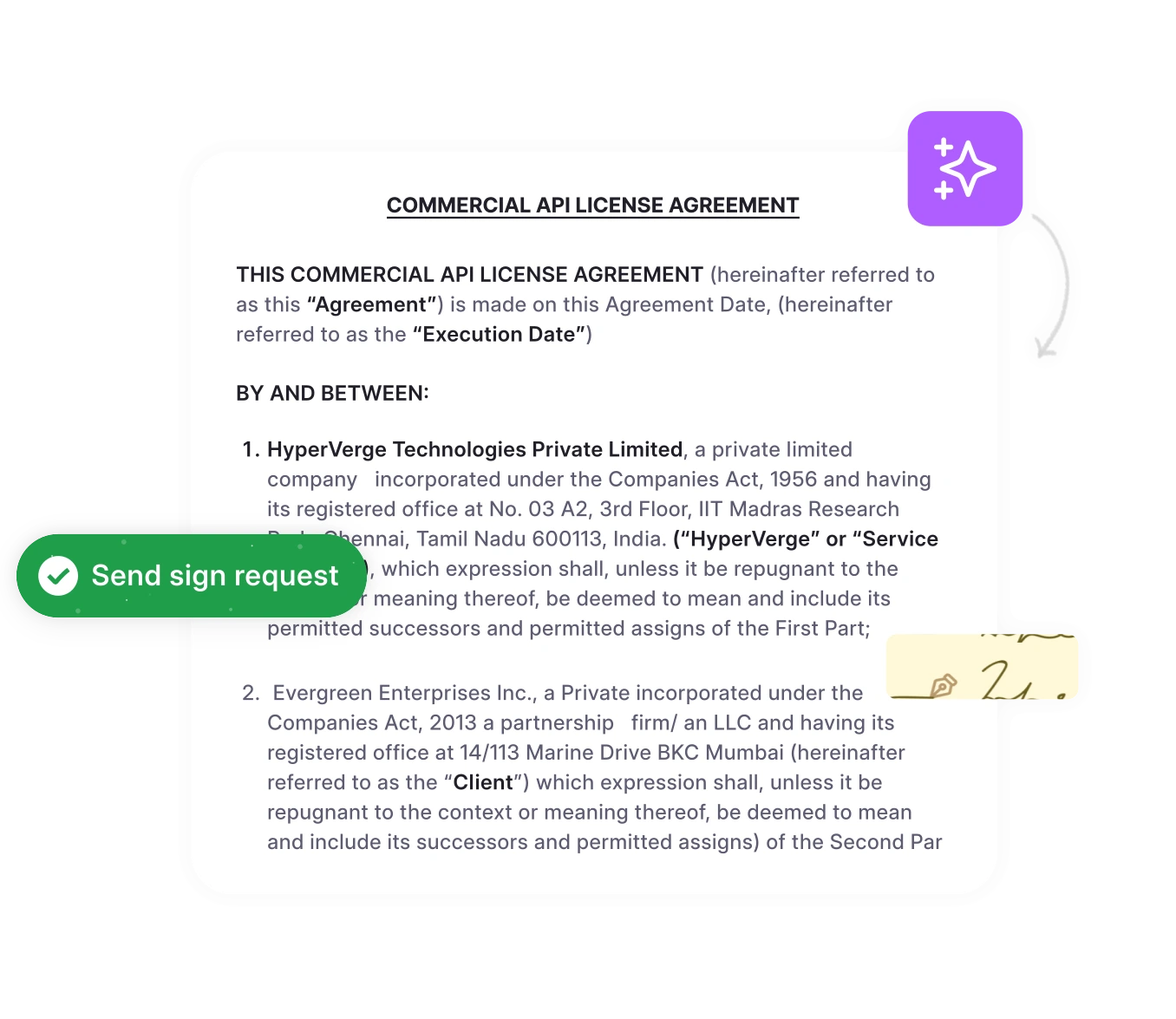Healthcare organizations face increasing pressure to safeguard patient data while navigating complex vendor relationships. A single misstep in vendor oversight can trigger HIPAA violations, resulting in penalties reaching millions of dollars and irreparable damage to patient trust.
Understanding what a Business Associate Agreement (BAA) is and when a BAA agreement is required remains critical for any covered entity that shares protected health information with third-party service providers.
This comprehensive guide covers everything you need to know about HIPAA BAA requirements, from basic definitions to common compliance failures. You’ll learn who needs to sign a business associate agreement, what components a business associate agreement must include, and how to avoid costly mistakes that jeopardize healthcare contract management compliance.
What is a business associate agreement?
A business associate agreement (BAA) is a legally binding contract required under HIPAA when a covered entity shares protected health information with a third-party vendor. Understanding a BAA helps healthcare organizations maintain compliance while engaging essential services. These agreements establish how third parties must handle, safeguard, and disclose PHI on behalf of covered entities.
HIPAA mandates that covered entities have a signed BAA HIPAA agreement before disclosing any PHI. When hospitals contract with billing companies for claims processing, those vendors become business associate HIPAA-designated and must sign BAAs. Clinics using cloud storage for electronic healthcare contracts and patient records need BAAs because a BAA for HIPAA compliance mandates that providers have potential PHI access.
BAAs serve as the foundation for HIPAA compliance in third-party relationships. They outline permitted uses of PHI, required safeguards, breach procedures, and patient access rights. Without proper agreements, both parties face significant compliance risks and potential enforcement actions.
Struggling to track vendor compliance?
Modern contract management platforms centralize tracking and automate renewal alerts to prevent compliance gaps.
Book a DemoWho needs a business associate agreement?
HIPAA requires BAAs whenever protected health information flows between covered entities and external parties performing specific functions. Three distinct categories of entities within the healthcare ecosystem face these requirements.
| Entity Type | Definition | Common Examples |
| Covered Entities | Healthcare providers, health plans, and clearinghouses that transmit PHI | Hospitals, clinics, insurance companies, and medical billing clearinghouses |
| Business Associates | Third parties that access PHI on behalf of covered entities | Billing companies, IT vendors, legal consultants, and accounting firms |
| Subcontractors | Third parties hired by business associates that access PHI | Cloud storage providers, data analytics firms, and transcription services |
When covered entities must have BAAs
Covered entities must establish BAAs before disclosing PHI to any external party performing services that involve creating, receiving, maintaining, or transmitting protected health information. Whether vendors directly view patient records or simply have technical access to systems containing PHI doesn’t matter. Both scenarios trigger requirements.
Services requiring BAAs include:
Access matters more than use. If contractors might encounter PHI while performing their duties, BAAs are required before work begins.
- Claims processing
- Practice management software hosting
- Legal representation involving patient records
- Document shredding services handling records with PHI
- Vendor contract management platforms that store agreements containing patient information
When business associates must have BAAs with subcontractors
Business associates face the same obligations as covered entities when they engage subcontractors who will access PHI. According to the HHS Office for Civil Rights, covered entities must enter into a HIPAA Business Associate Agreement with any business associate before PHI is disclosed, and ensure that subcontractors used by business associates also have written agreements in place.
HIPAA’s “flow-down” provisions require BAs to ensure their subcontractors provide the same level of protection for PHI that the original agreement requires.
A chain of responsibility extends throughout the vendor ecosystem.
A medical billing company (business associate) uses cloud backup services for patient data. That company must have a BAA with the cloud provider (subcontractor).
Failure to secure downstream agreements creates liability for both parties and the original covered entity.
Read also SaaS Agreement Essentials
Subcontractor BAAs must mirror the protections in primary agreements, ensuring consistent safeguards regardless of how many parties handle the PHI. Third-party contract management becomes increasingly complex as vendor relationships multiply.
Common business associate examples
Modern healthcare operations involve numerous business associate relationships, many of which organizations fail to recognize initially.
1. Medical Billing & Coding Services
These vendors routinely process detailed patient information for claims submission and payment processing, representing the most obvious category of business associates.
2. Technology Vendors
Technology vendors constitute a significant portion of business associates in today’s digital healthcare environment:
- Cloud providers: An AWS Business Associate Agreement is required when using Amazon Web Services for healthcare data storage or processing. Organizations need a Google Business Associate Agreement when using Google Cloud Platform or Google Workspace with PHI. A Microsoft HIPAA business associate agreement becomes necessary when using Azure or Microsoft 365 for healthcare operations.
- Storage solutions: Organizations may need a Dropbox HIPAA business associate agreement if using Dropbox for storing documents containing protected health information.
- EHR vendors and practice management software platforms
- Patient communication tools for appointment reminders and telehealth services
3. Professional Services
Professional service providers also fall under business associate requirements when their work involves PHI access:
- Legal, accounting, and consulting firms handling matters involving patient records
- Data analytics companies are processing healthcare information for research or business intelligence
- Marketing vendors accessing patient contact information
- Supplier contract management services handling agreements containing protected health information
Read also Top 25 Legal AI Tools
What must a business associate agreement include?
HIPAA regulations specify mandatory elements that every HIPAA business associate agreement must contain to satisfy HIPAA BAA requirements. Organizations can reference a sample business associate agreement to understand required provisions, though each agreement must be customized for specific relationships.
Consistent protections for patient privacy apply regardless of which third parties access PHI. Organizations cannot waive or modify these core provisions, though they may add additional protections beyond regulatory minimums.
| Requirement | Purpose | Key Details |
| Permitted uses | Define how BA can use PHI | Specific to services performed, limited by the minimum necessary standard |
| Prohibited uses | Clarify what BA cannot do | No sale of PHI, no unauthorized disclosure beyond agreement |
| Safeguards | Security measures required | Technical, physical, and administrative controls per HIPAA Security Rule |
| Breach reporting | Notification obligations | Report security incidents and breaches without unreasonable delay |
| Subcontractor agreements | Downstream BA requirements | Same protections must flow to all subcontractors accessing PHI |
| PHI access rights | Individual patient rights | Assist covered entity in providing patient access to their records |
| Termination | Contract ending provisions | Return or destruction of PHI, continued protection if not feasible |
Agreements must go beyond basic elements of a contract to address specific HIPAA requirements that don’t apply to standard commercial agreements. Using healthcare contract management software helps organizations standardize BAA templates and ensure required HIPAA clauses are consistently included.
Permitted uses and disclosures
BAAs must explicitly define the purposes for which third parties may use or disclose PHI. Uses must be limited to performing the services outlined in the underlying service agreement and any activities required by law. Third parties cannot use PHI for any purpose not specified in the agreement, even if such uses might benefit the covered entity.
HIPAA’s minimum necessary standard applies to all PHI disclosures under a BAA. Third parties may only access the minimum amount of PHI needed to perform their specific functions.
Medical billing services need patient demographics and diagnosis codes, but typically don’t require complete medical histories.
Security and safeguard requirements
Business associates must implement appropriate administrative, physical, and technical safeguards to prevent unauthorized PHI use or disclosure. Safeguards must comply with the HIPAA Security Rule, which establishes standards for electronic PHI protection, including:
- Access controls
- Encryption
- Audit logs
- Security training
BAAs should specify that third parties will conduct regular risk assessments, maintain incident response procedures, and implement measures to detect and respond to security incidents. Contract compliance with these security requirements is not optional. Business associates face direct liability for violating the Security Rule.
Breach notification and incident reporting
Agreements must require BAs to report any use or disclosure of PHI not permitted by the contract, including security incidents that constitute breaches of unsecured PHI. Third parties must notify covered entities without unreasonable delay and within 60 days after discovering a breach.
Critical Timeline: Third parties must notify covered entities within 60 days of discovering a breach; no exceptions.
Such notification enables covered entities to fulfill their own breach notification obligations to affected individuals, the Department of Health and Human Services, and potentially the media for significant breaches. BAAs should specify what information third parties must include in breach notifications and establish procedures for investigating and documenting incidents.
Termination and PHI disposition
Upon contract termination, BAs must:
- Return all PHI in their possession, OR
- Destroy all PHI (including information maintained by subcontractors), OR
- If return/destruction isn’t feasible, extend protections for as long as they maintain it.
Here, contract clause library resources typically include standard language for data disposition; however, BAAs require additional specificity regarding the handling of PHI. Agreements should address retention periods, secure destruction methods, and certification procedures that prove the disposal of PHI.
A BAA is a dynamic contract that must be regularly reviewed and updated—not just executed and forgotten. Rapid technological changes and evolving regulatory requirements mean that organizations must actively monitor and reassess their vendor compliance.
Read
What are the most common business associate agreement failures?
Despite clear regulatory requirements, organizations routinely make costly mistakes in BAA implementation and management. According to the OCR Phase 2 Audit Report, only 11% of covered entities audited showed no compliance deficiencies, highlighting the systemic risk of BAA gaps and inadequate vendor oversight.
Misunderstanding when BAAs are required, assuming contracts provide adequate protection, and overlooking less obvious vendor relationships all contribute to failures. Both covered entities and BAs face distinct compliance challenges that lead to violations.
Here are the 5 most common business associate agreement failures and how to avoid them:
1. Requiring BAAs when not necessary
The Mistake
- Cloud storage services
- Email platforms hosting messages with PHI
- Telecommunications providers transmitting electronic health records
- Network infrastructure handling patient data
Many covered entities overextend BAA requirements by insisting every contractor sign one regardless of PHI access. Unnecessary administrative burden follows. Vendors with no legitimate reason to sign HIPAA-compliant agreements often push back.
Scenario
Hospitals don’t need a business associate agreement template word document for janitorial services that clean patient rooms after discharge when no PHI is present. Organizations can download a free business associate agreement template or use a business associate agreement HIPAA template to create compliant agreements for legitimate relationships. However, applying these templates universally wastes resources.
Some covered entities impose blanket BAA requirements as a risk management strategy, believing excessive caution provides better protection. This approach wastes resources on unnecessary documentation and may indicate the organization doesn’t truly understand when PHI disclosure occurs.
How to Avoid It
Ask this determining question for every vendor: Does the contractor create, receive, maintain, or transmit PHI while performing their services?
- No PHI access = No BAA needed
- Potential PHI access = BAA required before work begins
2. Assuming a signed BAA equals HIPAA compliance
The Mistake
A signed BAA represents only the contractual framework for compliance, not actual adherence to HIPAA requirements. Covered entities often confuse contract execution with due diligence. They fail to verify that third parties implement required safeguards before disclosing PHI.
Business Associate Agreements are not just pieces of paper—they are critical tools for ensuring that vendors truly meet the requirements of HIPAA. Covered entities must perform due diligence to verify that a business associate actually implements the required safeguards, not just signs the contract.
Read
Scenario
Consider a medical practice that signs a BAA with an IT vendor but never verifies the vendor’s security measures. If the vendor lacks basic protections, such as encryption, access controls, or security incident procedures, the practice remains liable, even if it has a signed agreement.
OCR expects covered entities to investigate vendor capabilities before engagement and monitor compliance throughout the relationship. BAAs enable relationships but don’t guarantee third parties will fulfill their obligations.
How to Avoid It
Perform due diligence before and during vendor relationships:
- Review vendor security policies before contract signing
- Request audit reports or certifications
- Periodically reassess contract compliance audit practices
- Vet addenda and amendments
- Monitor ongoing compliance, not just at contract execution
3. Missing BAAs for “pass-through” services
The Mistake
Organizations commonly overlook vendor relationships when PHI merely passes through a service rather than being actively processed. Email providers, network infrastructure vendors, and data transmission services often escape BAA requirements. Covered entities don’t view them as accessing PHI.
Scenario
A critical compliance gap exists here. If patient information flows through a service, even temporarily, that service becomes a business associate requiring a BAA.
Services requiring BAAs even for pass-through access:
Many covered entities discovered this through enforcement actions after breaches at service providers they believed didn’t need agreements.
How to Avoid It
Rule: If patient information flows through a service, even temporarily, a BAA is required. Temporary or incidental access to PHI doesn’t eliminate BAA requirements.
4. No BAAs with subcontractors
The Mistake
Business associates frequently fail to recognize their obligation to obtain BAAs from their own subcontractors who access PHI. Significant liability follows. BAs bear the same responsibilities as covered entities when engaging downstream vendors.
Scenario
A medical billing company that subcontracts data entry work to a transcription service must have a BAA with that service if transcribers will access PHI. Billing companies using cloud backup services for patient data need agreements with those cloud providers.
Responsibility flows through every party handling PHI, regardless of how removed they are from the original covered entity. BAs sometimes believe their agreement with the covered entity satisfies all HIPAA requirements. Wrong. They must replicate those protections in contracts with their own subcontractors.
How to Avoid It:
Warning: Subcontractors face direct HIPAA liability. Your BAA with the covered entity doesn’t protect either you or them. Evaluate every downstream vendor for PHI access and secure BAAs before they begin work.
5. Ignoring the HIPAA Security Rule
The Mistake
Many BAs assume that encrypting data satisfies their HIPAA obligations. They fail to implement the comprehensive security program the Security Rule requires. Encryption represents just one safeguard among many that third parties must adopt.
Scenario
The Security Rule requires:
- Risk assessments to identify vulnerabilities
- Access controls limiting who can view PHI
- Audit controls tracking system activity
- Transmission security protects PHI in transit
- Workforce training on security procedures
- Security incident response procedures
- Disaster recovery plans
- Authentication protocols verifying user identities
- Emergency access mechanisms for PHI
How to Avoid It
Contract risk management requires understanding that HIPAA compliance involves ongoing security management, not simply deploying encryption technology. Business associates without documented risk assessments, incident response plans, and security policies face direct penalties. Breaches aren’t required for penalties.
Automate BAA compliance monitoring and renewals
Never miss a vendor compliance check or BAA renewal date with intelligent contract lifecycle management.
Book a DemoWhat are the consequences of BAA violations?
HIPAA violations carry severe financial and operational consequences for both covered entities and business associates. HHS Office for Civil Rights (OCR) enforces HIPAA requirements through investigations, corrective action plans, and monetary penalties that can reach millions of dollars annually. Understanding these consequences motivates organizations to prioritize BAA compliance and vendor management.
Financial penalties for covered entities and business associates
OCR employs a four-tier penalty structure based on the level of culpability, with penalties adjusted annually for inflation. The 2025 penalty structure reflects significantly increased financial exposure for HIPAA violations:
| Tier | Level of Culpability | Minimum Penalty Per Violation | Maximum Penalty Per Violation | Annual Penalty Cap |
| 1 | Unknowing, Lack of Knowledge | $141 | $71,162 | $71,162 (Tier 1 Cap) |
| 2 | Reasonable Cause, Not Willful Neglect | $1,424 | $71,162 | $142,355 (Tier 2 Cap) |
| 3 | Willful Neglect, Corrected within 30 days | $14,232 | $71,162 | $355,808 (Tier 3 Cap) |
| 4 | Willful Neglect, Not Corrected within 30 days | $71,162 | $2,134,831 | $2,134,831 (Tier 4 Cap) |
Source: HIPAA Journal
HIPAA violations often involve multiple infractions. A single missed BAA may constitute separate violations for the lack of a contract, inadequate safeguards, and improper disclosure of PHI. State Attorneys General also possess the authority to pursue HIPAA enforcement actions, creating additional exposure beyond federal penalties.
Business associates face identical penalty tiers and enforcement mechanisms as covered entities. OCR holds BAs directly accountable for their own HIPAA violations, including failing to obtain subcontractor agreements, failing to implement required safeguards, or improperly disclosing PHI.
BAs don’t operate under a covered entity’s umbrella of protection. Recent enforcement actions demonstrate OCR’s willingness to assess substantial penalties, particularly when failures contributed to significant data breaches affecting thousands or millions of patients.
Additional consequences beyond fines
1. Corrective Action Plans
Monetary penalties represent only one aspect of HIPAA enforcement. OCR typically requires organizations to adopt corrective action plans addressing systemic compliance weaknesses. Plans mandate specific improvements to policies, procedures, training, and technical safeguards, with implementation timelines and reporting requirements.
2. Multi-Year OCR Monitoring
Covered entities may face multi-year monitoring by OCR, submitting regular reports demonstrating continued compliance. Oversight consumes substantial internal resources and constrains operational flexibility. Organizations under corrective action plans must dedicate staff to compliance monitoring, documentation, and reporting while implementing potentially costly system improvements.
3. Reputation and Market Damage
Reputation damage from HIPAA violations and breaches erodes patient trust and can impact an organization’s ability to attract new patients or maintain partnerships. Healthcare providers face market consequences that extend beyond regulatory penalties. Negative media coverage, patient lawsuits, and competitive disadvantages all follow violations.
4. Civil Litigation Risk
Affected individuals may pursue civil litigation seeking damages for privacy violations and related harms. While HIPAA itself doesn’t create a private right of action, state privacy laws and negligence theories provide legal avenues for patients to seek compensation. Lawsuits create additional costs beyond OCR penalties, including legal fees, settlements, and potential judgments.
Read also Going from exhaustive to efficient: Legal operations
Contract termination requirements
When a covered entity becomes aware of a material breach of a BAA by a business associate, HIPAA requires specific remediation steps:
- Covered entity must take reasonable steps to cure the breach or end the violation
- If these efforts fail, contract termination is mandatory
- If contract termination is not feasible due to the critical nature of services or lack of alternative vendors, covered entities must report the problem to OCR
Covered entities face untenable positions in such scenarios, highlighting the importance of vendor diversification and contingency planning. Termination requirements create operational challenges when BA relationships involve mission-critical systems or services. Healthcare organizations facing BAA breaches by essential vendors must balance their immediate compliance obligations with the continuity of care and operational stability.
Manage business associate agreements with HyperStart
Manual BAA tracking creates compliance risks as vendor relationships multiply. Organizations struggle to maintain contract visibility into which third parties have current agreements, renewal dates, and whether subcontractor relationships comply with requirements.
Missed contract renewal dates create gaps in compliance and patient care delivery. Manual follow-ups drain resources from strategic initiatives. During audits, organizations often struggle to demonstrate due diligence or produce comprehensive vendor compliance records.
HyperStart transforms BAA management through intelligent automation:
- Centralized repository for all agreements with role-based access
- Automated renewal alerts prevent compliance lapses
- Vendor & HIPAA compliance tracking maintains audit trails
- Real-time reporting demonstrates compliance status
- Procurement integration ensures requirements are addressed upfront
Discover how healthcare organizations utilizing HyperStart, contract management software, transition from reactive vendor management to proactive compliance monitoring.












